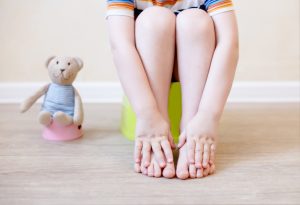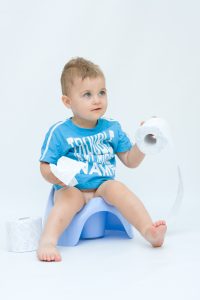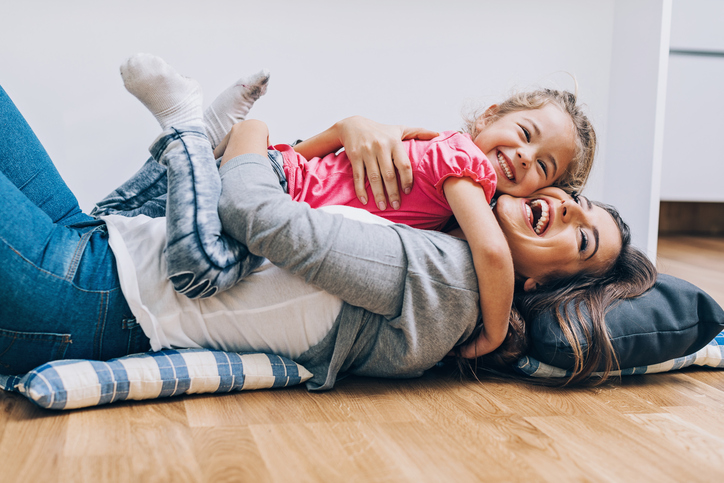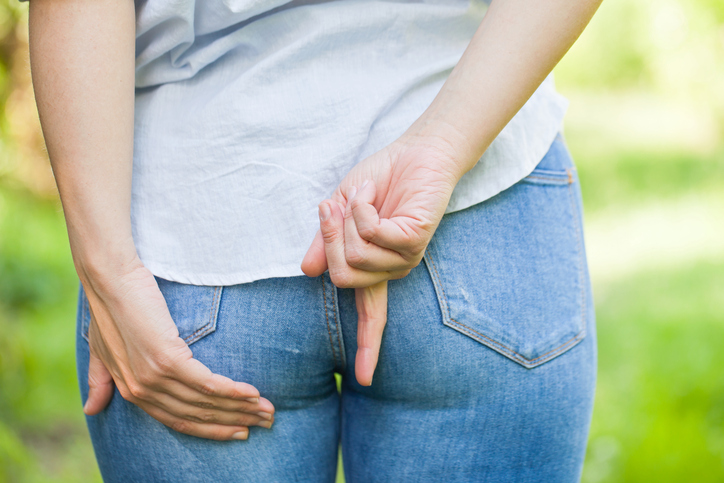AdviceDevelopmental ResourcesDiscipline Resources
Toilet Training
Toilet training!
It’s a wonderful parenting milestone when, after changing thousands of dirty nappies, you have successfully completed toilet training your child! Teaching your child to use a potty, and then for them to actually use it, takes patience. Change takes time, so don’t rush the process. Parents are sometimes concerned about: When do you start? How do you start? This article will give you ideas about both.
Goodbye nappies, hello underwear
The age when a child learns to go to the toilet by themselves, and how quickly he or she learns, is different for every child. Statistics indicate that it’s taking longer for today’s children to be potty trained than in the past. A 1957 study found 92 per cent of children were toilet trained by 18 months. A 2004 study (Children’s Hospital of Philadelphia) found that less than 25 per cent had been toilet trained by 18 months, 60 per cent were toilet trained by age 3 and 2 per cent remained untrained by age 4.
Body awareness
- My child can identify various body parts, including where urine and bowel movements come from.
Toilet words
- My child can tell me when he is dry or wet.
- My child can identify if he is soiled.
- My child uses specific words when he feels the urge to eliminate.
Follows simple instructions
- My child willingly follows simple instructions.
- My child can imitate tasks like putting her hands on her hips.
- My child can flush the toilet.
- My child can carry something to the bathroom and put it on the floor next to the toilet.
Coordination and dexterity
- My child can walk or run to the toilet.
- My child can pull up and down loose clothing like pants with an elasticised waist.
Bowel/bladder control
- My child can go several hours without wetting.
- My child has a few well-formed bowel movements each day rather than numerous small ones.
Toilet fears
- My child is not afraid of the toilet, or the sound of flushing water.
Is my child ready for toilet training?
Dr. Garber, an expert on childhood behaviour problems, has developed a readiness test for toilet training. Use this list to determine how ready your child is for toilet training. Most paediatricians suggest that children can’t be taught to eliminate in the toilet before the age of two, and that some won’t achieve success until well into their third year. While some children might achieve this milestone earlier, it’s not the norm. Toilet training shouldn’t begin until your child shows signs of readiness. It’s a lot easier to train your child when he or she is ready for it. Before the age of two a child has developed two important skills:
A. LANGUAGE SKILLS They can tell you when they want to go, and they can understand your directions.
B. PHYSICAL CONTROL By this age your child has better control over the sphincter and abdominal muscles.
There are four popular approaches to toilet training.
Each involves different time commitments, so select the one that best suits your personality.
OPTION A Natural method
Dr. Berry Brazelton, a world renowned paediatrician, suggests that if you have the patience, simply wait – because your child will eventually train himself! Place a potty in the toilet and explain to your child how to use it, and practice using it. Don’t pressure your child to use it, but give help if requested.
OPTION B Twice a day training
If your child is already having regulate bowel movements, sit them on the potty at the time they usually go. Give your child a book or toy while they are on the potty, so they don’t get bored. Use praise and encouragement for sitting on the potty. If they go toilet, give a reward. Through this process a child learns to use the potty.
OPTION C One day training
This option is for those parents in a hurry! The method is described by Dr’s Azrin and Foxx in their book “Toilet Training in Less Than a Day”. To use this method your child needs to be developmentally ready for toilet training (see the chart on page 1). This method involves spending a whole day with your child modelling, training, and then practising toilet skills.
OPTION D A week training
This method is the one I recommend because while it acknowledges children take time to learn new behavioural patterns and skills, it also teaches these skills in a relatively short time period. Here’s how it works:
HELPFUL INSIGHTS
Modelling
Let your child watch you go to the bathroom
Words
Children need appropriate toilet words so they can understand when directions are given. It doesn’t matter what words you use – wee, pee, toilet, potty, poopy, urinate – so long as they understand what you are saying
Identify child’s toilet responses
Children usually have a way of indicating when they are going to the toilet. By recognising this you can quickly label what your child is doing: “Do you want to do wee’s?” It’s important for your child to distinguish between being wet and dry
Loose fitting pants
Loose fitting pants helps your child pull them up and down
Potty
Buy a child sized potty for your child to sit on
MAKING IT WORK
1. Choose a day to begin
Naturally choose a time when work and family stresses are minimal, and you have the time to focus on teaching your child.
2. Prepare your child
Before the training day, share with your child that he is going to learn how to use a potty. Be positive and enthusiastic. Another great way to prepare your child is to buy a picture book on potty training.
3. Begin enthusiastically
On the day you begin the training, become a coach. Your child is on your team and you are there to help them achieve success. So lots of positives, cheers, rewards, motivators, smiles, you can do it, well done’s, etc. We all do better with encouragement!
4. Play a game
A doll can be useful in a practice session to show your child what to do when she wants to go to the toilet. It shows your child the process: going to the toilet, pulling down pants, sitting on potty, then using the potty. Use different places in your home to practice this step – doll playing outside; doll at the table; doll in bed, etc. The purpose of the game is for your child to help doll learn to go to the toilet.
Now apply the game to your child. Ask your child what he/she should do when he/she wants to go to the toilet. Give lots of praise when child tells you. Take your child to the toilet and ask what happens next. If child says ‘sit on potty’, offer praise. Ask what comes next. If replies ‘take off my pants’, offer praise and sit them on potty. At the end of sitting on potty wash their hands. Be sure to go through all these steps a few times so your child is familiar with the process.
GETTING READY
1. Spend the rest of the day with your child.
After the practice session give your child plenty to drink. This will get the bladder going quickly! Frequently remind your child what you want him to do if he needs to go to the toilet. Be on the lookout for signs that they want to go – holding onto their penis through their pants, or pulling faces like they want to go. Ask your child if he/she wants to go toilet. Be sure to encourage and praise your child for each correct step Check for dryness and wetness. Regularly have your child check her pants to see if they are dry. Ignore accidents. Expect accidents! When they happen simply go back to practising the process again: daddy I need to go wee’s, running to the toilet, pulling down pants, sitting on potty for several seconds.
Having your child practice the correct behaviour is important. Practice makes perfect. Ignore any negative comments your child makes about going to the potty. Washing hands. After sitting on the potty have your child wash hands.
2. Praise works wonders when it comes to establishing new habits.
In the beginning you’ll want to lavish your child with praise and rewards for correct behaviour. But as your child successfully completes tasks you can gradually lessen the amount of praise and rewards.
3. Stick with it
It’s often easier to teach children to urinate in a potty than to pass a bowel movement in a potty. Children will sometimes stay dry all day and then during naps when they have a nappy on, pass a bowel motion. This is perfectly normal, so don’t be concerned. When your child sits on the potty and passes a bowel motion, offer plenty of encouragement.
4. Encourage yourself
Keep a record of your child’s progress; times when they used potty correctly, and the number of accidents that occurred during the day. Your record will hopefully indicate your child is making progress. If accidents increase it’s back to more practice. Be patient with yourself and your child. Some children become potty trained quickly, others take awhile. Even when your child is potty trained you can still expect occasional accidents. Most accidents will occur when your child is tired, sick, or preoccupied by an exciting activity. Don’t overreact when your child has an accident. So no blaming, yelling, humiliating, or shaming. Children learn new skills best when their parents are warm, caring and have reasonable expectations. Be a ‘potty training’ coach that makes your child feel loved, valued and competent.
When a child feels good about themselves, they quickly learn. So relax . . . It will happen!
Research Study Results
Dr. Brazelton, over a 10 year period, surveyed 1170 children. His research studies found 80% of children trained without pressure between the ages of two and two and a half with no more than one accident a week. Of the remaining children, 100 learned after the age of three and another 100 at four years of age.
If your child is facing specific challenges with bed wetting or soiling or pooing their pants check out our specific blog here.
To stay up to date with our latest articles follow us and like us on FACEBOOK
Further Reading
Brazelton, T.B. (1997). Touchpoints: Your Child’s Emotional and Behavioral Development. Reading,
MA: Addison-Wesley Publishing.
Hogg.T. (2005). The Baby Whisperer Solves All Your Problems. London: Random House.
Sanders, M.R. (1992). Every Parent. Sydney: Addison-Wesley Publishing.



